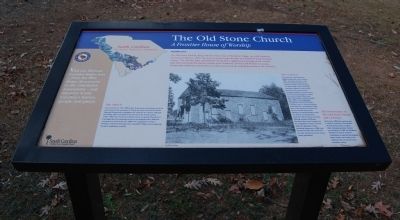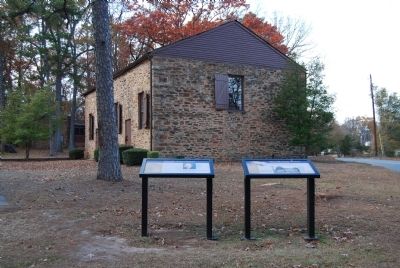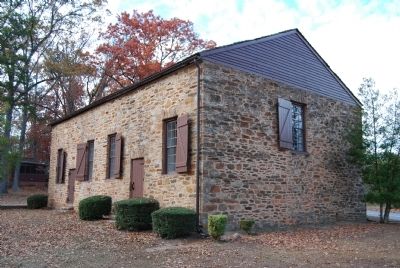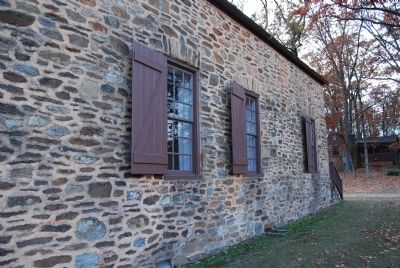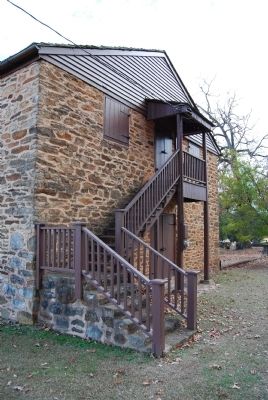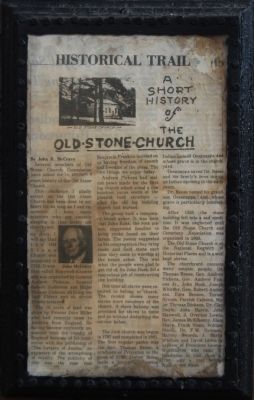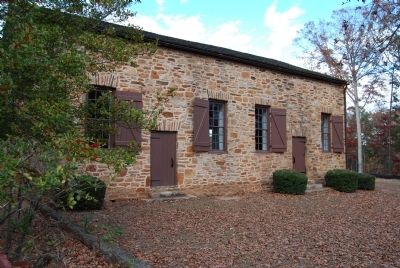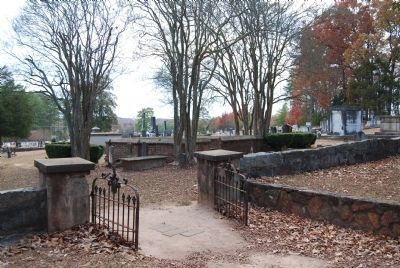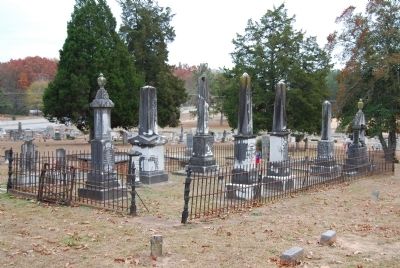Clemson in Pickens County, South Carolina — The American South (South Atlantic)
The Old Stone Church
A Frontier House of Worship
Significance
The Old Stone Church, along with the visitor sites of Pendleton Village, Fort Hill Plantation and Oconee Station, reflect the area's transition from frontier to antebellum South Carolina society. The Church's early membership constituted a significant percentage of the frontier elite who dominated Pendleton County (now Anderson, Oconee and Pickens Counties). Present-day Anderson and Pickens Counties are named for individuals buried in the cemetery.
The Church
Constructed from 1797-1802 by John Rusk (whose descendants would be instrumental in the early years of Texas), the stone structure served the Hopewell Presbyterian congregation for a quarter of a century. Although the building effort commenced near the end of the frontier period (1784-1798) when the threat of Indian attacks was greatly diminished, it is probable that this substantial structure was designed with a defensive component in mine. In the mid-1820s, the congregation moved to Pendleton, which had developed into a gentrified village and was beginning its role in antebellum social life.
The Cemetery
The oldest part of the burial area slightly predates the church. Charles Miller, who died in the fall of 1795, was one of the early burials in the cemetery. Charles was the younger son of John Miller, who was the first newspaper publisher in the Carolina upcountry and a noted London newspaper publisher during the years of the American Revolution. Located on a corner of John Miller's land grant, the property would be deeded after 1800 to the congregation. Presbyterians associated with the Pendleton area, or with early families entombed there, dominate the oldest parts of the cemetery. During much of the twentieth century, the cemetery served the broader needs of a diverse community often connected with Clemson University.Although numbers of African-American slaves were members of the congregation, none are buried within the graveyard. Those individuals dying prior to 1865 (and sometime later) were interred in the slave cemeteries on the various nearby plantations.
The Preservation of The Old Stone Church and Cemetery
By the late 1800s, the cemetery was in need of restoration. Descendants of those buried there, as well as other interested persons, formed an association. In 1902, the Pendleton Presbyterian Church created a Commission to care for the property. Major repairs were made to the building in the second half of the twentieth century.
Erected by South Carolina Heritage Corridor.
Topics and series. This historical marker is listed in these topic lists: African Americans
• Cemeteries & Burial Sites • Churches & Religion • Forts and Castles • Settlements & Settlers. In addition, it is included in the South Carolina Heritage Corridor series list. A significant historical year for this entry is 1795.
Location. 34° 39.85′ N, 82° 48.883′ W. Marker is in Clemson, South Carolina, in Pickens County. Marker is on Anderson Highway. Marker is located close to the church building. Touch for map. Marker is in this post office area: Clemson SC 29631, United States of America. Touch for directions.
Other nearby markers. At least 10 other markers are within walking distance of this marker. A different marker also named The Old Stone Church (here, next to this marker); Old Stone Church Confederate Memorial (within shouting distance of this marker); Old Stone Church / Old Stone Church Graveyard (about 500 feet away, measured in a direct line); Thomas Green Clemson Parkway (approx. 0.6 miles away); Blue Key National Honor Fraternity Gateway (approx. 0.7 miles away); "Widowmaker’s” Drill (approx. ¾ mile away); Hanover House (approx. ¾ mile away); a different marker also named Hanover House (approx. ¾ mile away); a different marker also named Hanover House (approx. 0.8 miles away); Hunt Cabin (approx. 0.8 miles away). Touch for a list and map of all markers in Clemson.
Also see . . .
1. Old Stone Church (Clemson). Old Stone Church is a church building built in 1802. When it was constructed, it was in the Pendleton District, South Carolina. (Submitted on December 15, 2008, by Brian Scott of Anderson, South Carolina.)
2. Old Stone Church and cemetery aka Hopewell Keowee Church. National Register of Historic Places Nomination Form (Submitted on May 29, 2022, by Larry Gertner of New York, New York.)
3. Old Stone Church and Cemetery. The Old Stone Church is significant architecturally as a masonry adaptation of meeting house architecture and as a representative of the early pioneer church in South Carolina. (Submitted on December 15, 2008, by Brian Scott of Anderson, South Carolina.)
Additional commentary.
1. About the Old Stone Church
Construction of Old Stone Church began in 1797 to replace a log meeting house which was burned. The natural fieldstone rectangular structures with medium gable roof was completed in 1802. Six bays deep with high fenestration, the windows are the size of its doorways. Flat arches with slight radiation of voussoirs are over doors and windows. Exterior stairs lead to slave gallery at rear of church.
Interior is simple, unornamented befitting the period; the wooden benches, raised wooden pulpit, pine floor, hand-hewn exposed beans evident in roof.
Statement of Significance: October 13, 1789, the congregation of Hopewell-Keowee Church asked to be taken into the Presbytery of South Carolina. Church named Hopewell from Treaty of Hopewell (1785) between settlers and Cherokee enacted in part by General Andrew Pickens and Keowee from a branch of the Seneca River. Later called Old Stone Church.
The first building having been destroyed by fire, a new church was built 1797-1802 by John Rusk.
Important politically and militarily for men of prominence instrumental in church's organization and buried in cemetery. Among these are: Revolutionary War Generals Andrew Pickens and Robert Anderson - principle founders and elders; Colonel Andrew Pickens (War of 1812) - elder, Governor of South Carolina.
In the area social/humanitarian, it is noteworthy for the Old Stone Church and Cemetery Commission, organized in the 1890s, which realized the importance of the building itself and its association with distinguished
men in South Carolina history. A wall was put around graveyard and repairs made to preserve the old building which had not been used since the 1830s. This Commission remains active in maintaining the church and cemetery.
Importance in religion/philosophy stems from its use as a religious center; the Reverend Thomas Reese, distinguished scholar, patriot, and first South Carolina minister to receive the degree of Doctor of Divinity, who served as pastor 1792-1796; church member "Printer" John Miller, publisher of South Carolina Gazette and Advertizer (Charleston), Junius Letters, and Miller's Weekly Messenger (Pendleton), whose essay "The Influence on Religion in Civil Society" testifies to the quality of South Carolina literature in 1788.
Significant architecturally as representative of the early pioneer church in South Carolina; masonry adaptation of meeting house architecture; built of local materials with outstanding exterior and interior masonry and woodwork craftsmanship. (Source: National Register nomination form.)
— Submitted July 4, 2009, by Brian Scott of Anderson, South Carolina.
Credits. This page was last revised on May 29, 2022. It was originally submitted on December 15, 2008, by Brian Scott of Anderson, South Carolina. This page has been viewed 1,532 times since then and 56 times this year. Photos: 1, 2, 3, 4, 5, 6, 7, 8, 9. submitted on December 15, 2008, by Brian Scott of Anderson, South Carolina.
